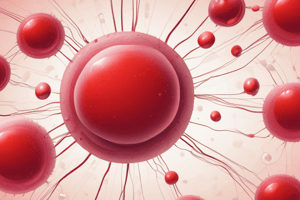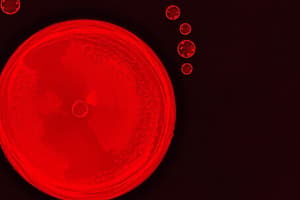Podcast
Questions and Answers
Anemia and prolonged heart failure can trigger the production of erythrocytes due to:
Anemia and prolonged heart failure can trigger the production of erythrocytes due to:
- Hormonal balance
- Healthy bone marrow
- Decreased O2 supply to the tissues (correct)
- Increased oxygen supply to the tissues
Where does erythropoiesis primarily occur after the age of 20?
Where does erythropoiesis primarily occur after the age of 20?
- Kidney
- Membranous bone marrow (correct)
- Bone marrow
- Liver and Spleen
What characterizes the shape of red blood cells (RBCs)?
What characterizes the shape of red blood cells (RBCs)?
- Irregular
- Biconcave (correct)
- Square
- Triangle
What is the normal size of RBCs?
What is the normal size of RBCs?
Which of the following conditions stimulates erythropoietin secretion?
Which of the following conditions stimulates erythropoietin secretion?
What is the main function of red blood cells (RBCs)?
What is the main function of red blood cells (RBCs)?
What blood viscosity assists in maintaining?
What blood viscosity assists in maintaining?
Certain conditions facilitate erythropoietin secretion. Which of the options is correct?
Certain conditions facilitate erythropoietin secretion. Which of the options is correct?
What can destroy bone marrow?
What can destroy bone marrow?
Besides the kidney, which other organ secretes erythropoietin?
Besides the kidney, which other organ secretes erythropoietin?
What is the role of the liver in erythropoiesis?
What is the role of the liver in erythropoiesis?
What hormone stimulates general metabolism, influencing erythropoiesis indirectly?
What hormone stimulates general metabolism, influencing erythropoiesis indirectly?
Which vitamin is called extrinsic factor?
Which vitamin is called extrinsic factor?
Vitamin B12 is essential for:
Vitamin B12 is essential for:
What may result from vitamin B12 deficiency?
What may result from vitamin B12 deficiency?
Intrinsic factor of Castle is produced in:
Intrinsic factor of Castle is produced in:
In whose absence, vitamin B12 is not absorbed from the intestine, leading to pernicious anemia?
In whose absence, vitamin B12 is not absorbed from the intestine, leading to pernicious anemia?
Where does a deficiency of intrinsic factor of Castle occur?
Where does a deficiency of intrinsic factor of Castle occur?
In comparison to the volume of RBCs what does the biconcave shape result in?
In comparison to the volume of RBCs what does the biconcave shape result in?
What leads to megaloblastic anemia?
What leads to megaloblastic anemia?
Which mineral is a heme part of hemoglobin?
Which mineral is a heme part of hemoglobin?
Why is copper important to erythropoiesis?
Why is copper important to erythropoiesis?
Cobalt is essential of what vitamin?
Cobalt is essential of what vitamin?
Which of the following characteristics does NOT describe RBCs?
Which of the following characteristics does NOT describe RBCs?
If oxygen supply decreases to the tissues, what happens to the rate of erythrocytes production?
If oxygen supply decreases to the tissues, what happens to the rate of erythrocytes production?
Where does erythropoiesis take place during fetal life?
Where does erythropoiesis take place during fetal life?
The bone marrow is essential for:
The bone marrow is essential for:
What is the chemical nature of erythropoietin?
What is the chemical nature of erythropoietin?
Other than stimulating erythropoietin secretion, androgens directly promotes:
Other than stimulating erythropoietin secretion, androgens directly promotes:
The RBC membrane:
The RBC membrane:
What causes spherocytosis?
What causes spherocytosis?
Erythropoiesis:
Erythropoiesis:
What of the following is essential for adequate erythropoiesis?
What of the following is essential for adequate erythropoiesis?
Flashcards
Why are RBCs biconcave?
Why are RBCs biconcave?
A biconcave disc shape increases the surface area of the RBC.
RBC shape and nucleus
RBC shape and nucleus
RBCs have a circular, biconcave disc shape but lack a nucleus.
Functions of red blood cells
Functions of red blood cells
Blood viscosity, hemoglobin for gas transport, membrane to contain hemoglobin, membrane for blood groups.
Erythropoiesis
Erythropoiesis
Signup and view all the flashcards
Sites of Erythropoiesis
Sites of Erythropoiesis
Signup and view all the flashcards
Factors affecting erythropoiesis
Factors affecting erythropoiesis
Signup and view all the flashcards
Androgens' role in erythropoiesis
Androgens' role in erythropoiesis
Signup and view all the flashcards
Maturation factors for RBCs
Maturation factors for RBCs
Signup and view all the flashcards
Vitamin B12's role
Vitamin B12's role
Signup and view all the flashcards
Intrinsic factor production
Intrinsic factor production
Signup and view all the flashcards
Folic acid for maturation
Folic acid for maturation
Signup and view all the flashcards
Diet for erythropoiesis
Diet for erythropoiesis
Signup and view all the flashcards
Main content & Function of RBCs
Main content & Function of RBCs
Signup and view all the flashcards
Study Notes
- Module covering "Blood and Immune" topics for Semester 2
RBCs (Red Blood Cells) General Overview
- RBCs are circular and biconcave in shape
- Average RBC diameter is 7.2 μm, and their thickness is 2.2 μm
- RBCs lack a nucleus, ribosomes, and mitochondria, therefore technically aren't true cells
- Primarily composed of hemoglobin (Hb)
- Main function is to transport oxygen (O2) and carbon dioxide (CO2)
Biconcave Shape of RBCs
- Biconcave shape increases the surface area of RBCs
- This shape is maintained by ankyrin and spectrin proteins
- Problems with this shape is is absent in spherocytosis
- The shape results in minimal membrane tension when volume increases
Key RBC Metrics
- Normal RBC count in adult males is 5.4 million/mm3
- Normal RBC count in adult females is 4.8 million/mm3
- RBCs are circular, biconcave, and non-nucleated
- Biconcave shape increases the surface area-to-volume (S/V) ratio
- Biconcave shape enables RBCs to pass through narrow capillaries
- Average RBC size is 7.5 µm in diameter, 2 µm thick with a .90 cubic microns volume
- Hemoglobin (Hb) concentration:
- Men: ~16 g/dl
- Women: ~14 g/dl
Functions of RBCs
- Contributes to the maintenance of blood viscosity, which is essential for maintaining arterial blood pressure (ABP)
- Essential to carry oxygen and carbon dioxide
- Membrane keeps hemoglobin inside and prevents its escape into the plasma
- Membrane contains agglutinogens that determine blood groups
- Shape increases the surface area for gas exchange
- High degree of flexibility: they can deform into almost any shape enables passage through narrow vessels
- After deformation, they can resume their normal shape
Erythropoiesis
- Erythropoiesis is the process of origin, development, and maturation of erythrocytes
- Hemopoiesis (or hematopoiesis) is the process of origin, development, and maturation of all blood cells
Sites of Erythropoiesis
- Fetal life: Liver, spleen, and bone marrow
- After birth: Bone marrow
- After 20 years of age: Membranous bone marrow in vertebrae, sternum, ribs, ilia, and upper ends of the humerus and femur
Factors Affecting Erythropoiesis
- Erythrocyte numbers are regulated to provide sufficient tissue oxygenation
- Key factors influencing erythropoiesis include:
- Oxygen supply to the tissues and the role of erythropoietin
- Healthy bone marrow
- Healthy liver
- Hormones
- Diet
Oxygen Supply and Erythropoietin
- Conditions that decrease O2 supply increase the production rate of erythrocytes
- Conditions leading to increased rate of production include:
- High altitude
- Increased oxygen demand in athletes
- Chronic respiratory diseases (e.g. COPD)
- Anemia
- Prolonged heart failure
Stimulating Secretion of Erythropoietin
- Hypoxia
- There is evidence that oxygen tension in the kidney is the major factor regulating erythropoiesis
- Alkalosis that develops during acclimatization to high altitude
- Cobalt salts and androgens
- β-adrenergic stimulants and adenosine facilitate erythropoietin secretion
Erythropoietin Overview
- Glycoprotein with 165 amino acids
- Major quantity secreted by peritubular capillaries of the kidney, and a small quantity is also secreted from the liver
- The stimulant for secretion is hypoxia
Healthy Bone Marrow
- Essential for the production of erythrocytes
- The bone marrow can be destroyed by X-rays, atomic radiation, and drugs such as chloramphenicol
- Bone marrow can also be destroyed by malignant tumors leading to aplastic anemia
Healthy Liver
- Essential for erythropoiesis
- Site of the globin portion formation for hemoglobin
- Formation of 10% of erythropoietin hormone
- Storage of iron and vitamin B12
Hormones That affect Erythropoiesis
- Erythropoietin hormone
- Androgens stimulate erythropoietin secretion
- Thyroid hormone stimulates general metabolism
Maturation Factors
- Vitamin B12, intrinsic factor, and folic acid are necessary for RBC maturation
Vitamin B12 (Cyanocobalamin)
- Necessary maturation factor for erythropoiesis
- Also called extrinsic factor since it is primarily obtained from the diet
- Absorption from the intestine requires the presence of intrinsic factor of Castle
- Stored mostly in the liver and, in small quantities, in muscle
- When necessary, transported to the bone marrow to promote RBC maturation
- Also produced in the large intestine by intestinal flora
Action of Vitamin B12
- Essential for DNA synthesis in RBCs
- Deficiency leads to failure in cell maturation and reduction in cell division
- The resultant cells are larger with fragile/weaker cell membranes, causing macrocytic anemia
- Deficiency causes pernicious anemia
- Vitamin B12 can be called an antipernicious factor
Intrinsic Factor of Castle
- Produced in gastric mucosa by the parietal cells of the gastric glands
- Essential for the absorption of vitamin B12 from the intestine
- Absence leads to vitamin B12 not being absorbed from the intestine, resulting in pernicious anemia
- Deficiency occurs due to:
- Severe gastritis
- Ulcer
- Gastrectomy
Folic Acid
- Essential for maturation and required for DNA synthesis
- Absence leads to decreased DNA synthesis, causing failure of maturation
- This leads to megaloblastic anemia
Diet and nutrition
- A proper diet is essential for erythropoiesis because it facilitates the production of erythrocytes
- Adequate Dietary measures include consuming essential factors such as:
- Proteins of high biological value.
- Minerals:
- Iron :Heme part of hemoglobin.
- Copper important for iron absorption from GIT
- Cobalt as Co-factors for formation of Hb.
- Cobalt as a part of vit. B12.
- Vitamins: Vitamin C. Vitamin B12. Folic acid.
Studying That Suits You
Use AI to generate personalized quizzes and flashcards to suit your learning preferences.




